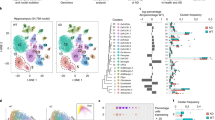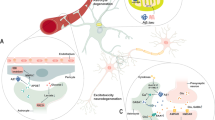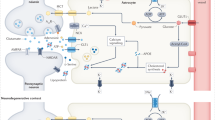Abstract
Glial fibrillary acidic protein (GFAP) is considered to be a highly specific marker for glia. Here, we report on the expression of GFAP in neurons in the human hippocampus. Intriguingly, this neuronal GFAP is coded by out-of-frame splice variants and its expression is associated with Alzheimer pathology. We identified three novel GFAP splice forms: Δ 135 nt, Δ exon 6 and Δ 164 nt. Neuronal GFAP is mainly observed in the pyramidal neurons of the hippocampus of Alzheimer and Down syndrome patients and aged controls, but not in neurons of patients suffering from hippocampal sclerosis. Apparently, the hippocampal neurons in patients with Alzheimer's disease pathology are capable of expressing glia-specific genes.
This is a preview of subscription content, access via your institution
Access options
Subscribe to this journal
Receive 12 print issues and online access
$259.00 per year
only $21.58 per issue
Buy this article
- Purchase on Springer Link
- Instant access to full article PDF
Prices may be subject to local taxes which are calculated during checkout








Similar content being viewed by others
References
Ott A, Breteler MM, van Harskamp F, Claus JJ, van der Cammen TJ, Grobbee DE et al. Prevalence of Alzheimer's disease and vascular dementia: association with education. The Rotterdam study. BMJ 1995; 310: 970–973.
Selkoe DJ . The cell biology of beta-amyloid precursor protein and presenilin in Alzheimer's disease. Trends Cell Biol 1998; 8: 447–453.
Alonso AC, Grundke-Iqbal I, Iqbal K . Alzheimer's disease hyperphosphorylated tau sequesters normal tau into tangles of filaments and disassembles microtubules. Nat Med 1996; 2: 783–787.
Van Leeuwen FW, De Kleijn DPV, Van den Hurk HH, Neubauer A, Sonnemans MAF, Sluijs JA et al. Frameshift mutants of β amyloid precursor protein and ubiquitin-B in Alzheimer's and Down patients. Science 1998; 279: 242–247.
Muramori F, Kobayashi K, Nakamura I . A quantitative study of neurofibrillary tangles, senile plaques and astrocytes in the hippocampal subdivisions and entorhinal cortex in Alzheimer's disease, normal controls and non-Alzheimer neuropsychiatric diseases. Psychiatry Clin Neurosci 1998; 52: 593–599.
Hanzel DK, Trojanowski JQ, Johnston RF, Loring JF . High-throughput quantitative histological analysis of Alzheimer's disease pathology using a confocal digital microscanner. Nat Biotechnol 1999; 17: 53–57.
Beach TG, Walker R, McGeer EG . Patterns of gliosis in Alzheimer's disease and aging cerebrum. Glia 1989; 2: 420–436.
Van Leeuwen FW, Burbach JPH, Hol EM . Mutations in RNA: a first example of molecular misreading in Alzheimer's disease. Trends Neurosci 1998; 21: 331–335.
Van Leeuwen FW, Fischer DF, Kamel D, Sluijs JA, Sonnemans MAF, Benne R et al. Molecular misreading: a new type of transcript mutation expressed during aging. Neurobiol Aging 2000; 21: 879–891.
Hol EM, Neubauer A, De Kleijn DPV, Sluijs JA, Ramdjielal RDJ, Sonnemans MAF et al. Dinucleotide deletions in neuronal transcripts: a novel type of mutation in non-familial Alzheimer's disease and Down syndrome patients. Prog Brain Res 1998; 117: 379–395.
Evans DAP, Van der Kleij AAM, Sonnemans MAF, Burbach JPH, Van Leeuwen FW . Frameshift mutations at two hotspots in vasopressin transcripts in post-mitotic neurons. Proc Natl Acad Sci USA 1994; 91: 6059–6063.
Brenner M . Structure and transcriptional regulation of the GFAP gene. Brain Pathol 1994; 4: 245–257.
Reeves SA, Helman LJ, Allison A, Israel MA . Molecular cloning and primary structure of human glial fibrillary acidic protein. Proc Natl Acad Sci USA 1989; 86: 5178–5182.
Brenner M, Johnson AB, Boespflug-Tanguy O, Rodriguez D, Goldman JE, Messing A . Mutations in GFAP, encoding glial fibrillary acidic protein, are associated with Alexander disease. Nat Genet 2001; 27: 117–120.
Aoki Y, Haginoya K, Munakata M, Yokoyama H, Nishio T, Togashi N et al. A novel mutation in glial fibrillary acidic protein gene in a patient with Alexander disease. Neurosci Lett 2001; 312: 71–74.
Messing A, Goldman JE, Johnson AB, Brenner M . Alexander disease: new insights from genetics. J Neuropathol Exp Neurol 2001; 60: 563–573.
Braak H, Braak E . Neuropathological stageing of Alzheimer-related changes. Acta Neuropathol 1991; 82: 239–259.
Thal DR, Rub U, Orantes M, Braak H . Phases of A beta-deposition in the human brain and its relevance for the development of AD. Neurology 2002; 58: 1791–1800.
Dahl D, Bignami A . Immunogenic properties of the glial fibrillary acidic protein. Brain Res 1976; 116: 150–157.
Neumann M, Gabel D . Simple method for reduction of autofluorescence in fluorescence microscopy. J Histochem Cytochem 2002; 50: 437–439.
Jicha GA, Bowser R, Kazam IG, Davies P . Alz-50 and MC-1, a new monoclonal antibody raised to paired helical filaments, recognize conformational epitopes on recombinant tau. J Neurosci Res 1997; 48: 128–132.
van Den Hurk WH, Willems HJ, Bloemen M, Martens GJ . Novel frameshift mutations near short simple repeats. J Biol Chem 2001; 276: 11496–11498.
Seidl R, Cairns N, Lubec G . The brain in Down syndrome. J Neural Transm Suppl 2001; 61: 247–261.
Proper EA, Oestreicher AB, Jansen GH, Veelen CW, van Rijen PC, Gispen WH et al. Immunohistochemical characterization of mossy fibre sprouting in the hippocampus of patients with pharmaco-resistant temporal lobe epilepsy. Brain 2000; 123: 19–30.
Bender BL, Yunis EJ . Central nervous system pathology of tube-rous sclerosis in children. Ultrastruct Pathol 1980; 1: 287–299.
Probst A, Ulrich J, Heitz PU . Senile dementia of Alzheimer type: astroglial reaction to extracellular neurofibrillary tangles in the hippocampus. Acta Neuropathol 1982; 57: 75–79.
Yamaguchi H, Morimatsu M, Hirai S, Takahashi K . Alzheimer's neurofibrillary tangles are penetrated by astroglial processes and appear eosinophilic in their final stages. Acta Neuropathol 1987; 72: 214–217.
Feinstein DA, Weinmaster GA, Milner R . Isolation of cDNA clones encoding rat glial fibrillary acidic protein: expression in astrocytes and in Schwann cells. J Neurosci Res 1992; 32: 1–14.
Zelenika D, Grima B, Brenner M, Pessac B . A novel glial fibrillary acidic protein mRNA lacking exon 1. Brain Res Mol Brain Res 1995; 30: 251–258.
Condorelli DF, Nicoletti VG, Barresi V, Conticello SG, Caruso A, Tendi EA et al. Structural features of the rat GFAP gene and identification of a novel alternative transcript. J Neurosci Res 1999; 56: 219–228.
Nielsen AL, Holm IE, Johansen M, Bonven BJ, Jorgensen P, Jorgensen AL . A new splice form of glial fibrillary acidic protein, GFAP epsilon, interacts with the presenilin proteins. J Biol Chem 2002; 277: 29983–29991.
Mount SM . Genomic sequence, splicing, and gene annotation. Am J Hum Genet 2000; 67: 788–792.
Eng LF . Glial fibrillary acidic protein (GFAP): the major protein of glial intermediate filaments in differentiated astrocytes. J Neuroimmunol 1985; 8: 203–214.
Gomi H, Yokoyama T, Fujimoto K, Ikeda T, Katoh A, Itoh T et al. Mice devoid of the glial fibrillary acidic protein develop normally and are susceptible to scrapie prions. Neuron 1995; 14: 29–41.
Pekny M, Johansson CB, Eliasson C, Stakeberg J, Wallen A, Perlmann T et al. Abnormal reaction to central nervous system injury in mice lacking glial fibrillary acidic protein and vimentin. J Cell Biol 1999; 145: 503–514.
Inagaki M, Nakamura Y, Takeda M, Nishimura T, Inagaki N . Glial fibrillary acidic protein: dynamic property and regulation by phosphorylation. Brain Pathol 1994; 4: 239–243.
Laywell ED, Rakic P, Kukekov VG, Holland EC, Steindler DA . Identification of a multipotent astrocytic stem cell in the immature and adult mouse brain. Proc Natl Acad Sci USA 2000; 97: 13883–13888.
Kondo T, Raff M . Oligodendrocyte precursor cells reprogrammed to become multipotential CNS stem cells. Science 2000; 289: 1754–1757.
McShea A, Harris PL, Webster KR, Wahl AF, Smith MA . Abnormal expression of the cell cycle regulators P16 and CDK4 in Alzheimer's disease. Am J Pathol 1997; 150: 1933–1939.
Vincent I, Jicha G, Rosado M, Dickson DW . Aberrant expression of mitotic cdc2/cyclin B1 kinase in degenerating neurons of Alzheimer's disease brain. J Neurosci 1997; 17: 3588–3598.
Dranovsky A, Vincent I, Gregori L, Schwarzman A, Colflesh D, Enghild J et al. Cdc2 phosphorylation of nucleolin demarcates mitotic stages and Alzheimer's disease pathology. Neurobiol Aging 2001; 22: 517–528.
Yang Y, Geldmacher DS, Herrup K . DNA replication precedes neuronal cell death in Alzheimer's disease. J Neurosci 2001; 21: 2661–2668.
Lam YA, Pickart CM, Alban A, Landon M, Jamieson C, Ramage R et al. Inhibition of the ubiquitin-proteasome system in Alzheimer's disease. Proc Natl Acad Sci USA 2000; 97: 9902–9906.
Lindsten K, de Vrij FM, Verhoef LG, Fischer DF, van Leeuwen FW, Hol EM et al. Mutant ubiquitin found in neurodegenerative disorders is a ubiquitin fusion degradation substrate that blocks proteasomal degradation. J Cell Biol 2002; 157: 417–427.
De Vrij FMS, Sluijs JA, Gregori L, Fischer DF, Hermens WTJMC, Goldgaber D et al. Mutant ubiquitin expressed in Alzheimer's disease causes neuronal death. FASEB J 2001; 15: 2680–2688.
Acknowledgements
We thank the Netherlands Brain Bank team (coordinator R Ravid) for the human post-mortem brain material, CWM van Veelen and PC van Rijen for the biopsy material and P Davies for supplying the MC1 antiserum. The research is supported by HFSP (RG0148/1999-B), NWO-MW (903-51-179) and NWO-memory processes and dementia (970-10-029 and 970-10-002), EU 5th framework (QLRT-02238), Hersenstichting Nederland (H00.06). EA Proper was supported by the Epilepsy Fund of the Netherlands (96-04).
Author information
Authors and Affiliations
Corresponding author
Rights and permissions
About this article
Cite this article
Hol, E., Roelofs, R., Moraal, E. et al. Neuronal expression of GFAP in patients with Alzheimer pathology and identification of novel GFAP splice forms. Mol Psychiatry 8, 786–796 (2003). https://doi.org/10.1038/sj.mp.4001379
Received:
Revised:
Accepted:
Published:
Issue Date:
DOI: https://doi.org/10.1038/sj.mp.4001379
Keywords
This article is cited by
-
Biomarkers: Role and Scope in Neurological Disorders
Neurochemical Research (2023)
-
Forensic biomarkers of lethal traumatic brain injury
International Journal of Legal Medicine (2022)
-
Ghrelin peptide improves glial conditioned medium effects on neuronal differentiation of human adipose mesenchymal stem cells
Histochemistry and Cell Biology (2021)
-
GFAP positivity in neurons following traumatic brain injuries
International Journal of Legal Medicine (2021)
-
Therapeutic Advancement in Neuronal Transdifferentiation of Mesenchymal Stromal Cells for Neurological Disorders
Journal of Molecular Neuroscience (2021)



